
The rove beetles are a family (Staphylinidae) of beetles, primarily distinguished by their short elytra that typically leave more than half of their abdominal segments exposed. With roughly 63,000 species in thousands of genera, the group is currently recognized as the largest extant family of organisms. It is an ancient group, with fossilized rove beetles known from the Triassic, 200 million years ago, and possibly even earlier if the genus Leehermania proves to be a member of this family. They are an ecologically and morphologically diverse group of beetles, and commonly encountered in terrestrial ecosystems.

Lovage, Levisticum officinale, is a tall perennial plant, the sole species in the genus Levisticum in the family Apiaceae, subfamily Apioideae. It has been long cultivated in Europe, the leaves being used as a herb, the roots as a vegetable, and the seeds as a spice, especially in southern European cuisine.

Primula vulgaris, the common primrose, is a species of flowering plant in the family Primulaceae, native to western and southern Europe, northwest Africa, and parts of southwest Asia. The common name is primrose, or occasionally common primrose or English primrose to distinguish it from other Primula species also called primroses. None of these are closely related to the evening primroses.

Chroogomphus is a genus of mushrooms commonly known as pine-spikes or spike-caps based on their shape and because they are often found growing in association with pine trees. The genus is distributed throughout the Northern Hemisphere including North America, the Caribbean, Europe, and Asia.

Taraxacum officinale, the dandelion or commondandelion, is a flowering herbaceous perennial plant of the dandelion genus in the family Asteraceae. The common dandelion is well known for its yellow flower heads that turn into round balls of many silver-tufted fruits that disperse in the wind. These balls are usually called "clocks" in both British and American English. The name "blowball" is also used.

Symphytum officinale is a perennial flowering plant in the family Boraginaceae. Along with thirty four other species of Symphytum, it is known as comfrey. To differentiate it from other members of the genus Symphytum, this species is known as common comfrey or true comfrey. Other English names include Quaker comfrey, cultivated comfrey, boneset, knitbone, consound, and slippery-root. It is native to Europe, growing in damp, grassy places. It is locally frequent throughout Ireland and Britain on river banks and ditches. It occurs elsewhere, including North America, as an introduced species and sometimes a weed. The flowers are mostly visited by bumblebees. Internal or long-term topical use of comfrey is discouraged due to its strong potential to cause liver toxicity.

Hoplodrina ambigua, the Vine's rustic, is a moth of the family Noctuidae. It is found in the western Palearctic realm.
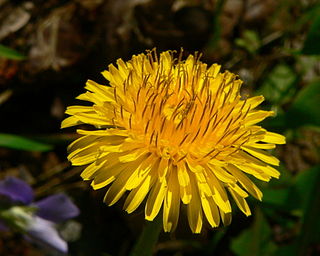
Taraxacum is a large genus of flowering plants in the family Asteraceae, which consists of species commonly known as dandelions. The scientific and hobby study of the genus is known as taraxacology. The genus is native to Eurasia and North America, but the two most commonplace species worldwide, T. officinale and T. erythrospermum, were introduced into North America from Europe and now propagate as wildflowers. Both species are edible in their entirety. The common name dandelion is also given to specific members of the genus.

Byturidae, also known as Fruitworms, is a very small family of beetles, in the suborder Polyphaga, comprising fewer than 20 species worldwide. The larvae of some species develop in fruits. Byturus unicolor affects species of Rubus and Geum.
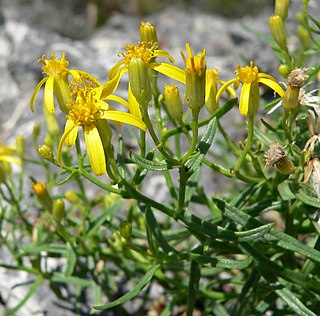
Senecio spartioides is a species of flowering plant in the aster family known by the common name broom-like ragwort. It is native to the western United States as far east as the Dakotas and Texas, and northern Mexico. It can be found in dry, rocky, often disturbed areas in a number of habitat types. It is a subshrub which can exceed a meter in height, its arching stems growing from a woody-topped taproot. The leaves are linear in shape and up to 10 centimeters long. The leaves usually have smooth, unlobed edges, but slightly lobed leaves are seen at times. The leaves are evenly distributed along the stems, the ones low on the stems withering away early, giving the plant a naked appearance on the lower half while the top is still lush green and blooming. The inflorescences are spreading, flat-topped arrays of many cylindrical flower heads. The heads contain yellow disc florets and generally either 5 or 8 ray florets each about a centimeter long.
The Brachypsectridae are a family of beetles commonly known as the Texas beetles. There are only two extant genera, Brachypsectra and Asiopsectra. The type species, Brachypsectra fulva, occurs in North America. Other species in the genus have a cosmopolitan distribution. Two other extant and fossil species have been described from the Dominican Republic. While formerly considered monogeneric, in 2016 Asiopsectra was described from specimens found in Iran and Tajikistan. Two extinct genera, Vetubrachypsectra and Hongipsectra, known from adults, and a larval genus, Cretopsectra are known from Cenomanian aged Burmese amber.

Papuaepilachna guttatopustulata, the large leaf-eating ladybird, is a species of ladybird, formerly in the genus Henosepilachna endemic to parts of Australasia, specifically New South Wales, Queensland, the Bismarck Archipelago, New Guinea, New Hebrides and Solomon Islands.
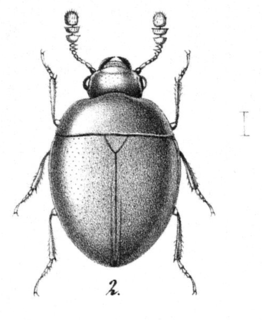
Gelae is a genus of round fungus beetles belonging to the family Leiodidae. The beetles are found in different parts of Central and North America. They are small and rounded, feeding on slime moulds. They were originally placed in the genus Agathidium following the discovery of the first species, G. cognatum, in 1878. The taxonomic position was revised with description of new species in 2004 by American entomologists Kelly B. Miller and Quentin D. Wheeler. Upon creation of the new genus, the five new species are Gelae baen, G. belae, G. donut, G. fish, and G. rol.

Hakea recurva, commonly known as jarnockmert, is a shrub or tree of the genus Hakea native to an area in the Mid West, northern Wheatbelt and the Goldfields-Esperance regions of Western Australia.
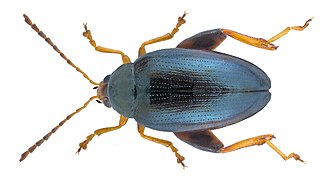
Psylliodes chrysocephala or Psylliodes chrysocephalus, commonly known as the cabbage-stem flea beetle, is a species of leaf beetle situated in the subfamily Galerucinae and the tribe Alticini.

Orites acicularis, commonly known as yellow bush, is an angiosperm endemic to Tasmania, Australia and is a member of the genus Orites within the family Proteaceae. The species was first described in 1810 by Scottish botanist Robert Brown in Transactions of the Linnean Society of London.
Xerasia is a genus of fruitworm beetles in the family Byturidae. There are four described species in Xerasia.
Byturus unicolor, known generally as raspberry fruitworm, is a species of fruitworm beetle in the family Byturidae. Other common names include the western raspberry fruitworm and fruitworm beetle. It is found in Central America and North America.
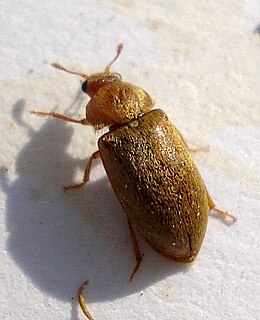
Byturus is a genus of fruitworm beetles in the family Byturidae. There are five described species in Byturus.
Abscondita chinensis, is a species of firefly beetle found in India, China and Sri Lanka.

















